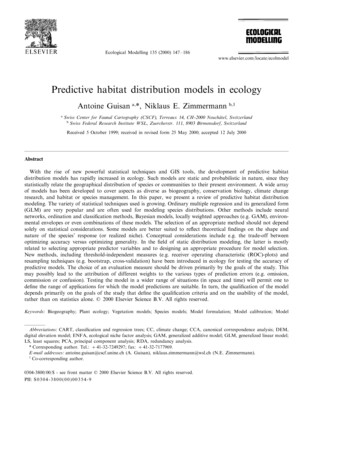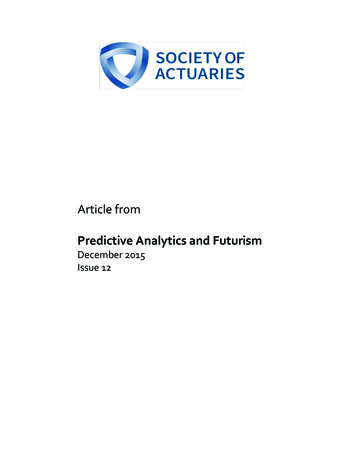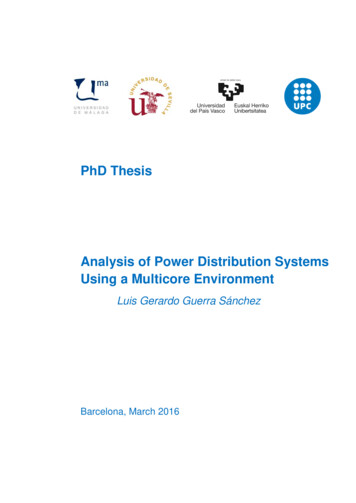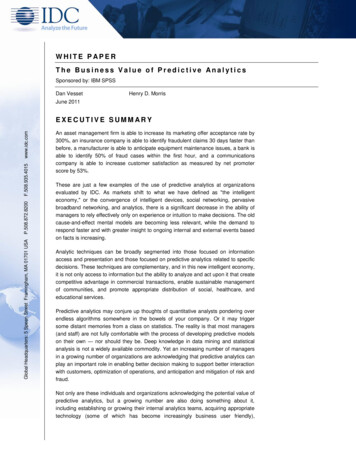
Transcription
Ecological Modelling 135 (2000) 147 – 186www.elsevier.com/locate/ecolmodelPredictive habitat distribution models in ecologyAntoine Guisan a,*, Niklaus E. Zimmermann b,1aSwiss Center for Faunal Cartography (CSCF), Terreaux 14, CH-2000 Neuchâtel, SwitzerlandbSwiss Federal Research Institute WSL, Zuercherstr. 111, 8903 Birmensdorf, SwitzerlandReceived 5 October 1999; received in revised form 25 May 2000; accepted 12 July 2000AbstractWith the rise of new powerful statistical techniques and GIS tools, the development of predictive habitatdistribution models has rapidly increased in ecology. Such models are static and probabilistic in nature, since theystatistically relate the geographical distribution of species or communities to their present environment. A wide arrayof models has been developed to cover aspects as diverse as biogeography, conservation biology, climate changeresearch, and habitat or species management. In this paper, we present a review of predictive habitat distributionmodeling. The variety of statistical techniques used is growing. Ordinary multiple regression and its generalized form(GLM) are very popular and are often used for modeling species distributions. Other methods include neuralnetworks, ordination and classification methods, Bayesian models, locally weighted approaches (e.g. GAM), environmental envelopes or even combinations of these models. The selection of an appropriate method should not dependsolely on statistical considerations. Some models are better suited to reflect theoretical findings on the shape andnature of the species’ response (or realized niche). Conceptual considerations include e.g. the trade-off betweenoptimizing accuracy versus optimizing generality. In the field of static distribution modeling, the latter is mostlyrelated to selecting appropriate predictor variables and to designing an appropriate procedure for model selection.New methods, including threshold-independent measures (e.g. receiver operating characteristic (ROC)-plots) andresampling techniques (e.g. bootstrap, cross-validation) have been introduced in ecology for testing the accuracy ofpredictive models. The choice of an evaluation measure should be driven primarily by the goals of the study. Thismay possibly lead to the attribution of different weights to the various types of prediction errors (e.g. omission,commission or confusion). Testing the model in a wider range of situations (in space and time) will permit one todefine the range of applications for which the model predictions are suitable. In turn, the qualification of the modeldepends primarily on the goals of the study that define the qualification criteria and on the usability of the model,rather than on statistics alone. 2000 Elsevier Science B.V. All rights reserved.Keywords: Biogeography; Plant ecology; Vegetation models; Species models; Model formulation; Model calibration; ModelAbbre6iations: CART, classification and regression trees; CC, climate change; CCA, canonical correspondence analysis; DEM,digital elevation model; ENFA, ecological niche factor analysis; GAM, generalized additive model; GLM, generalized linear model;LS, least squares; PCA, principal component analysis; RDA, redundancy analysis.* Corresponding author. Tel.: 41-32-7249297; fax: 41-32-7177969.E-mail addresses: antoine.guisan@cscf.unine.ch (A. Guisan), niklaus.zimmermann@wsl.ch (N.E. Zimmermann).1Co-corresponding author.0304-3800/00/ - see front matter 2000 Elsevier Science B.V. All rights reserved.PII: S 0 3 0 4 - 3 8 0 0 ( 0 0 ) 0 0 3 5 4 - 9
148A. Guisan, N.E. Zimmermann / Ecological Modelling 135 (2000) 147–186predictions; Model evaluation; Model credibility; Model applicability; GIS; Statistics1. IntroductionThe analysis of species – environment relationship has always been a central issue in ecology.The importance of climate to explain animal andplant distribution was recognized early on (Humboldt and Bonpland, 1807; de Candolle, 1855).Climate in combination with other environmentalfactors has been much used to explain the mainvegetation patterns around the world (e.g. Salisbury, 1926; Cain, 1944; Good, 1953; Holdridge,1967; McArthur, 1972; Box, 1981; Stott, 1981;Walter, 1985; Woodward, 1987; Ellenberg, 1988).The quantification of such species – environmentrelationships represents the core of predictive geographical modeling in ecology. These models aregenerally based on various hypotheses as to howenvironmental factors control the distribution ofspecies and communities.Besides its prime importance as a research toolin autecology, predictive geographical modelingrecently gained importance as a tool to assess theimpact of accelerated land use and other environmental change on the distribution of organisms(e.g. climate – Lischke et al., 1998; Kienast et al.,1995, 1996, 1998; Guisan and Theurillat, 2000), totest biogeographic hypotheses (e.g. Mourell andEzcurra, 1996; Leathwick, 1998), to improvefloristic and faunistic atlases (e.g. Hausser, 1995)or to set up conservation priorities (Margules andAustin, 1994). A variety of statistical models iscurrently in use to simulate either the spatialdistribution of terrestrial plant species (e.g. Hill,1991; Buckland and Elston, 1993; Carpenter etal., 1993; Lenihan, 1993; Huntley et al., 1995;Shao and Halpin, 1995; Franklin, 1998; Guisan etal., 1998, 1999), aquatic plants (Lehmann et al.,1997; Lehmann, 1998), terrestrial animal species(e.g. Pereira and Itami, 1991; Aspinall, 1992; Augustin et al., 1996; Corsi et al., 1999; Mace et al.,1999; Manel et al., 1999; Mladenoff et al., 1995,1999), fishes (Lek et al., 1996; Mastrorillo et al.,1997), plant communities (e.g. Fischer, 1990;Brzeziecki et al., 1993; Zimmermann and Kienast,1999), vegetation types (e.g. Brown, 1994; Van deRijt et al., 1996), plant functional types (e.g. Box,1981, 1995, 1996), biomes and vegetation units ofsimilar complexity (Monserud and Leemans,1992; Prentice et al., 1992; Tchebakova et al.,1993, 1994; Neilson, 1995), plant biodiversity (e.g.Heikkinen, 1996; Wohlgemuth, 1998), or animalbiodiversity (Owen, 1989; Fraser, 1998) (see alsoScott et al., in press for numerous additionalexamples of plant and animal species distributionmodels). Such static, comparative, models are opposed to more mechanistic models of ecosystemprocesses (Peters, 1991; Jones, 1992; Pickett et al.,1994; Lischke et al., 1998). Since only very fewspecies have been studied in detail in terms oftheir dynamic responses to environmental change,static distribution modeling often remains theonly approach for studying the possible consequences of a changing environment on speciesdistribution (Woodward and Cramer, 1996).The development of predictive models is coherent with Peters’s (1991, p. 274) view of a ‘‘morerigorously scientific, more informative and moreuseful ecology’’. The use of and theoretical limitations of static models compared with dynamicapproaches have been described in several papers(e.g. Decoursey, 1992; Korzukhin et al., 1996;Lischke et al., 1998). Franklin (1995) provides areview of some currently used statistical techniques in vegetation and plant species modeling.Particular aspects of model development (e.g. verification, calibration, evaluation ( validation),qualification) have been covered in more specificpapers, with very special attention given in recentyears to evaluation and its usefulness for testingecological models (e.g. Loehle, 1983; Oreskes etal., 1994; Rykiel, 1996). Since then, new statisticaltechniques for calibrating and testing predictivemodels have emerged (see e.g. Scott et al., inpress).The aim of this paper is to review the varioussteps of predictive modeling, from the conceptualmodel formulation to prediction and application(Fig. 1). We discuss the importance of differentiating between model formulation, model calibration, and model evaluation. Additionally, we
A. Guisan, N.E. Zimmermann / Ecological Modelling 135 (2000) 147–186149Fig. 1. Overview of the successive steps (1–5) of the model building process, when two data sets – one for fitting and one forevaluating the model – are available. Model evaluation is either made: (a) on the calibration data set using bootstrap,cross-validation or Jack-knife techniques; (b) on the independent data set, by comparing predicted to observed values usingpreferentially a threshold-independent measure (such as the ROC-plot approach for presence/absence models).provide an overview of specific analytical, statistical methods currently in use.2. Conceptual model formulationThe process, which ends with the formulationof an ecological model, usually starts from anunderlying ecological concept (e.g. the pseudoequilibrium assumption in static distributionmodeling). We consider it crucial to base theformulation of an ecological model on an underlying conceptual framework. Hereafter, we discussa selection of important conceptual aspects.2.1. General patterns in the geographicaldistribution of speciesThe core theory of predictive modeling of bioticentities originates from major trends published inthe field of biogeography. Here, our aim is not tosummarize all the patterns and processes of geographic range limitation, which are best providedby specific review papers (e.g. Brown et al., 1996),but to illustrate the link with the conceptualmodel formulation through examples.A matter of primary interest is the relativeimportance of biotic versus abiotic factors at themargins of a species’ range. Brown et al. (1996)recalls that ‘‘in most ecological gradients, themajority of species appear to find one direction tobe physically stressful and the other to be biologically stressful’’. This was stressed for an elevationgradient (Guisan et al., 1998) and already suggested for latitudinal gradient by Dobzhansky(1950) and McArthur (1972). In a more generalway, physical limits are caused by environmentaland physiological constraints (i.e. direct and resource gradients in the sense of Austin et al.(1984) and Austin and Gaywood (1994) undersuboptimal conditions along these gradients (e.g.too cold, too dry). A discussion on (1) usingcausal rather than non-causal factors and (2) considering inter-species competition for fitting astatic model follows in the next sections and in thefinal perspectives.
150A. Guisan, N.E. Zimmermann / Ecological Modelling 135 (2000) 147–1862.2. Generality, reality, and precisionNature is too complex and heterogeneous to bepredicted accurately in every aspect of time andspace from a single, although complex, model.Levins (1966) formulated the principle that onlyany two out of three desirable model properties(generality, reality, precision) can be improvedsimultaneously (Fig. 2), while the third propertyhas to be sacrificed. This trade-off leads to adistinction of three different groups of models(Sharpe, 1990; Prentice and Helmisaari, 1991; Korzukhin et al., 1996), and its associated constraintsare consequential when selecting modeling approaches for specific project goals.The first group of models (i) focuses on generality and precision. Such models are called analytical (Pickett et al., 1994) or mathematical2 (Sharpe,1990), and are designed to predict accurate response within a limited or simplified reality. TheLotka–Volterra equation and their variants(Volterra, 1926; May, 1981), the general logisticgrowth equation, or the Blackman growth law(Assmann ex Sharpe, 1990) are examples of analytical models. A second group of models (ii) isdesigned to be realistic and general. They areFig. 2. A classification of models based on their intrinsicproperties. After Levins (1966), and Sharpe (1990).2We find this term misleading, since all of the three principal modeling approaches may rely on more or less extensivemathematical formulations.called mechanistic (e.g. Prentice, 1986a), physiological (e.g. Leersnijder, 1992), causal (e.g. Decoursey, 1992) or process models (e.g. Korzukhinet al., 1996), and they base predictions on realcause–effect relationships. Thus they may also beconsidered as general, since these relationships areconsidered as biologically functional (Woodward,1987). A model of this group is not judged primarily on predicted precision, but rather on thetheoretical correctness of the predicted response(Pickett et al., 1994). A third group of models (iii)sacrifices generality for precision and reality. Suchmodels are called empirical (Decoursey, 1992; Korzukhin et al., 1996), statistical (Sharpe andRykiel, 1991), or phenomenological (Pickett et al.,1994; Leary, 1985). The mathematical formulation of such a model is not expected to describerealistic ‘cause and effect’ between model parameters and predicted response, nor to inform aboutunderlying ecological functions and mechanisms,being the main purpose to condense empiricalfacts (Wissel, 1992)3.Although Levins’ classification is helpful, it issomewhat misleading. In practice it can bedifficult to classify a specific model (Korzukhin etal., 1996). Predictive distribution models are generally categorized as empirical models; however,Prentice et al. (1992) argue that their (predictive)global vegetation model, rigorously based on independent physiological data and physiologicalfirst principles, is as mechanistic as we wouldachieve with limited data. Also Korzukhin et al.(1996) point out that process and empirical models can both have either a high or low degree ofgenerality depending on the nature of the objectbeing modeled, and that mechanistic models bytheir nature do not necessarily have to be imprecise. They conclude that precision, generality andreality are not always mutually exclusive. Similarly, Peters (1991, p.32) notices that, ‘‘there is nonecessary conflict between precision andgenerality’’.3Several authors do not distinguish clearly between analytical and empirical models (e.g. Loehle, 1983; Wissel, 1992),they use multiple criteria to arrange models along these gradients (e.g. Pickett et al., 1994), or they introduce subclasses toLevins’ model classification (Kimmins and Sollins, 1989; Kimmins et al., 1990).
A. Guisan, N.E. Zimmermann / Ecological Modelling 135 (2000) 147–186Loehle (1983) recognizes two distinct types ofmodels: calculating tools and theoretical models.The first can be put in the class of empiricalmodels, since ‘‘they are intended only to informus about the configuration of the world’’ (Peters,1991, p. 105), whereas the theoretical models aresynonymous with the mechanistic models, capableof predicting response from plausible causalrelations.We argue that Levins’ classification and tradeoffs are nevertheless useful in a conceptual context (see below). They help to focus on one or theother characteristics in model building, dependingon the overall goal of the modeling effort. Predictive vegetation models are generally empirical bynature. However, they can be based on physiologically meaningful parameters (e.g. Prentice et al.,1992; Lenihan, 1993), and can thus be describedas more mechanistic than models based, say, ontopographic parameters only (e.g. Burke et al.,1989; Moore et al., 1991). This difference summarizes the main axis along which most of thepredictive vegetation models can be arranged: inmost cases it is the trade-off between precisionand generality.2.3. Direct 6ersus indirect predictorsFrom a mechanistic point of view, it is desirableto predict the distribution of biotic entities on thebasis of ecological parameters that are believed tobe the causal, driving forces for their distributionand abundance. Such ecological factors are generally sampled from digital maps, since they areusually difficult or expensive to measure. However, they often tend to be less precise than puretopographic characteristics. Most bioclimaticmaps are developed by elevation-sensitive spatialinterpolations of climate station data (Hutchinsonand Bischof, 1983; Daly et al., 1994; Thornton etal., 1997). This introduces spatial uncertaintiesbecause of (i) interpolation errors, (ii) lack ofsufficient stations data, and (iii) the fact thatstandard climate stations do not reveal the biologically relevant microclimates. Soil (and nutrient)and geology maps are even more difficult toderive. They are usually generated at very coarseresolution and are often drawn up using vegeta-151tion as delineation criteria. On the other hand,available digital elevation models (DEM) tend tobe relatively accurate, even in mountainous terrain. Thus, directly derived topographic variables(slope, aspect, topographic position, or slopecharacteristics) are generated without much lossof precision. It is thus not surprising that predictive vegetation models, developed for mountainous terrain at relatively high spatial resolution,are based partially or completely on topographical factors (Fischer, 1990; Moore et al., 1991;Brzeziecki et al., 1993; Brown, 1994; Guisan et al.,1998, 1999). On the contrary, large-scale predictive models are generally based solely on biophysical parameters, since topography no longer hasany predictive power at such coarse resolution(Box, 1981; Prentice et al., 1992; Lenihan, 1993;Huntley et al., 1995; Neilson, 1995).The distinction between topographic and bioclimatic variables is important in the discussion ofprecision versus generality. Austin (1980, 1985),Austin et al. (1984), and Austin and Smith (1989)defined three types of ecological gradients, namelyresource, direct, and indirect gradients. Resourcegradients address matter and energy consumed byplants or animals (nutrients, water, light forplants, food, water for animals). Direct gradientsare environmental parameters that have physiological importance, but are not consumed (temperature, pH). Indirect gradients are variablesthat have no direct physiological relevance for aspecies’ performance (slope, aspect, elevation, topographic position, habitat type, geology; Fig. 3gives an example for vascular plants). They aremost easily measured in the field and are oftenused because of their good correlation with observed species patterns. Indirect variables usuallyreplace a combination of different resources anddirect gradients in a simple way (Guisan et al.,1999).However, one drawback of using such indirectparameters is that a model can only be appliedwithin a limited geographical extent without significant errors, because in a different region thesame topographic position can reveal a differentcombination of direct and resource gradients.Walter and Walter (1953) called this the ‘‘law ofrelative site constancy’’ (Gesetz der relati6en Stan-
152A. Guisan, N.E. Zimmermann / Ecological Modelling 135 (2000) 147–186Fig. 3. Example of a conceptual model of relationships between resources, direct and indirect environmental gradients (see e.g.Austin and Smith, 1989), and their influence on growth, performance, and geographical distribution of vascular plants andvegetation.dortkonstanz). It describes the fact that speciestend to compensate regional differences in climatic conditions by selecting comparable microsites by changing their topographic positions.In turn, the use of direct and resource gradients aspredictive parameters – in which case predictionsare based on what is supposed to be more physiologically ‘mechanistic’ – ensures that the model ismore general and applicable over larger areas.Furthermore, direct and resource gradients helpto pave the way towards incorporating dynamicaspects of vegetation succession in spatially explicit models, as proposed by Solomon and Leemans (1990) or by Halpin (1994).2.4. Fundamental 6ersus realized nicheThe fundamental niche is primarily a functionof physiological performance and ecosystem constraints. As an example, Woodward (1987, 1992)analyzed the mechanistic relationships betweenclimate parameters and plant fundamental response. The realized niche additionally includesbiotic interactions and competitive exclusion (Ellenberg, 1953; Malanson et al., 1992; Malanson,1997). The concept of the ecological niche wasclarified by Hutchinson (1957) and recently revisited by several authors in the context of predictivemodeling (e.g. Austin et al., 1990; Westman, 1991;
A. Guisan, N.E. Zimmermann / Ecological Modelling 135 (2000) 147–186Malanson et al., 1992; de Swart et al., 1994;Rutherford et al., 1995; Franklin, 1995; Leibold,1995). Differentiating between the fundamentaland the realized niche of a species is particularlyimportant because it distinguishes whether a simulated distribution is predicted from theoreticalphysiological constraints or rather from fieldderived observations.Strict mechanistic models parameterize the fundamental niche and additionally implement rulesof competitive behavior to finally result in thepredictions of the realized response. As an example, Prentice et al. (1992) based their model primarilyontheoreticalandphysiologicalconstraints, and they add simple rules to copewith succession and dominance. Static predictivemodels are generally based on large empirical fielddata sets, thus, they are likely to predict therealized (ecological) niche. This seriously limitsapplications in changing environmental situations.However, Malanson et al. (1992) demonstratehow empirically fitted response surfaces can bealtered on the basis of theoretical and physiological principles to design a more fundamentalresponse.2.5. Equilibrium 6ersus non-equilibriumStatic distribution models are developed fromsimple statistically or theoretically derived response surfaces. Thus, they automatically assumeequilibrium – or at least pseudo-equilibrium (Lischke et al., 1998) – between the environment andobserved species patterns. The non-equilibriumconcept is more realistic in ecology (Pickett et al.,1994), because it includes equilibrium as a possible state (Clark, 1991). However, a model basedon the non-equilibrium concept must be (i) dynamic and (ii) stochastic. Static distribution models are conceptually unable to cope withnon-equilibrium situations, since they do not distinguish between the transient and equilibriumresponse of species to a stochastically and dynamically changing environment. Hence, considering astate of equilibrium is a necessary assumption forthe purpose of large-scale distribution modeling.This limitation is less restrictive for species, orcommunities, which are relatively persistent or153react slowly to variability in environmental conditions (e.g. arctic and alpine).Such a drawback is compensated by large-scaleprediction with less effort, and the advantage thatno detailed knowledge of the physiology and behavior of the species involved is necessary. Situations with strong disturbance, human influence, orsuccessional dynamics can thus only be modeledwith difficulty (Brzeziecki et al., 1993; Guisan etal., 1999; Lees and Ritman, 1991; Zimmermannand Kienast, 1999). However, it is sometimespossible to include such factors as predictiveparameters4. The alternative to static, equilibriummodeling is dynamic simulation modeling (Korzukhin et al., 1996; Lischke et al., 1998). However, since such models require intensiveknowledge of the species involved, most of thesemodels are developed for well-investigate speciesand habitats. Only few dynamic models have yetbeen developed in a spatially explicit way thatallow simulations on larger spatial scales (e.g.Urban et al., 1991; Moore and Noble, 1993;Roberts, 1996; He et al., 1999; He and Mladenoff,1999).2.6. Species 6ersus community approachAnother major discussion in this field iswhether a model is said to be ‘gleasonian’ or‘clementsian’ (Prentice et al., 1992) simulatingspecies either individually or as community assemblages (see also Franklin, 1995). This discussion is embedded in the community-continuumdebate (Clements, 1916, 1936; Gleason, 1926;Cooper, 1926; Whittaker, 1967; McIntosh, 1967;Austin, 1985; Austin and Smith, 1989; Collins etal., 1993).A main argument for species modeling is thepaleoecological evidence that plant species assem4Fischer (1990) identified land-use as the factor with thehighest predictive power when modeling community distribution in a human-disturbed landscape. Lees and Ritman (1991)discussed the trade-off between spectral (remotely sensed data)and spatial (environmental GIS data) accuracy to respectivelypredict disturbed (e.g. rural or urban) versus undisturbed (e.g.rainforest) landscapes. Box (1981) as well as Prentice et al.(1992) included hierarchical rules to cope with succession, bysimulating mature stages only.
154A. Guisan, N.E. Zimmermann / Ecological Modelling 135 (2000) 147–186Fig. 4. Criteria for model selection. Examples of considerations for modeling vascular plant species in space and/or time, given aset of possible criteria to reach the project goals, CC: climatic change.blages have never been stable, mostly due to pastvariations in climate (Webb, 1981; Prentice,1986b; Ritchie, 1986). Modern species assemblages do not have long histories (Davis, 1983;Birks, 1993) and therefore, communities are notlikely to move as an entity under changing climatic conditions (Birks, 1986; Huntley and Webb,1988). Hence, modeling species instead of communities comes closer to what is believed to berealistic5. An alternative to modeling communitiesis to simulate a selection of dominant species, andto classify their superimposed distributions afterwards, in order to generate simulated community5Franklin (1995) discusses the different points of view in thecontext of predictive vegetation mapping. She concludes that:‘‘ communities (and ecotones) are geographic entities, andtherefore can be predictively mapped. However, predictivemapping of species distributions presents far fewer definitionaluncertainties or abstractions. Often the distribution of speciesassemblages (plant communities) or functional types is predicted owing to methodological considerations (lack of sufficient data to model species distributions) rather than strongloyalty to the community concept.’’maps (Lenihan, 1993; Austin, 1998; Guisan andTheurillat, 2000). This approach solves the missing logic of arbitrary a priori classifications. However,whenpredictingfuturepotentialdistributions based on static models and scenariosof environmental change (e.g. climatic change),the same limitations apply to species and community models. Both approaches are based on equilibrium assumptions (between observed responseand environmental conditions) and lack the possibility of simulating the individualistic behavior ofspecies (i.e. seed dispersal, migration, plasticity,adaptation, etc.).2.7. Conceptual guidelinesSo far we discussed that conceptual considerations based on the overall goal of the study areessential for the design of an appropriate model.Fig. 4 gives an example of possible considerationsfor modeling the distribution of vascular plants.In general, if high predictive precision is requiredto model the distribution of biological entities on
A. Guisan, N.E. Zimmermann / Ecological Modelling 135 (2000) 147–186a large spatial scale under present environmentalconditions (e.g. Hausser, 1995), then static modeling is a valid and powerful approach. It may alsobe selected for modeling large-scale potential distributions under environmental change scenarios,but limitations apply, as previously discussed. Formodeling at small spatial scales and in complextopography the use of indirect variables mayprovide better predictions, while for simulationsat large spatial scales the use of direct and resource gradients should be the first choice.3. Sampling design, field survey, spatial scales,and the geographical modeling contextThe formulation of the conceptual model leadsideally (i) to the choice of an appropriate spatialscale (reviewed by Wiens, 1989; see alsoHengeveld, 1987; Fitzgerald and Lees, 1994a) forconducting the study, and (ii) to the selection of aset of conceptually (e.g. physiologically) meaningful explanatory variables for the predictive model(Fig. 3). Additionally, it may be helpful to designan efficient sampling strategy by identifying thosegradients that are believed to play a key role inthe model and should thus be considered primarily to stratify the sampling (Mohler, 1983; Austinand Heyligers, 1989, 1991; Wessels et al., 1998).The main environmental gradients in the studyarea (be it a small catchment or a large area) canbe identified in a preliminary exploratory analysis(e.g. Dufrêne and Legendre, 1991; Aspinall andLees, 1994) and used to define a sampling strategythat is especially designed to meet the requirements of the model objectives (Mohler, 1983).The gradsect approach – originally proposedby Helman (1983) and later improved by Gillisonand Brewer (1985) and by Austin and Heyligers(1989, 1991) – represents a compromise betweenrandomized sampling (distribution and replication) of multiple gradients along transects lity). It can easily be designed in a geographical information system (Cocks and Baird,1991; Neldner et al. 1995; Franklin et al., inpress1995) and can thus be adapted to the spatialresolution of any study area. Austin and Heyligers155(1991, p.36) provide a detailed list of the generalsteps that can be used to design a reasonablesurvey based on the gradsect method.Designing the sampling according to a randomstratified scheme is another classical approachthat can also be set up in a GIS. However,difficulties may arise from studies that involvemany environmental gradients and many species,since setting up a multi-gradient stratified sampling is a particularly demanding task (Goedickemeier et al., 1997; Lischke et al., 1998). IndividualGIS layers have to be stratified and intersected inorder to delineate the polygons from which random samples have to be drawn. Each polygonrepresents a specific combination of environmental conditions, and each of these combinations(stratum) is usually present in multiple polygons.Next, a given number of polygons per stratum isselected randomly where samples have to be located. Restrictions may be applied, suc
modeling). We consider it crucial to base the formulation of an ecological model on an under-lying conceptual framework. Hereafter, we discuss a selection of important conceptual aspects. 2.1. General patterns in the geographical distribution of species The core theory of predictive modeling










